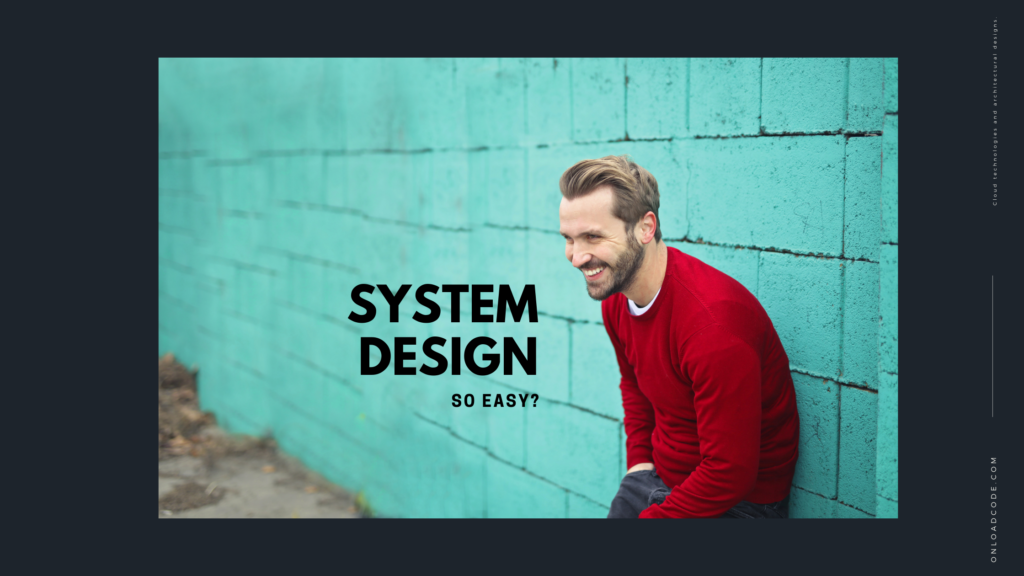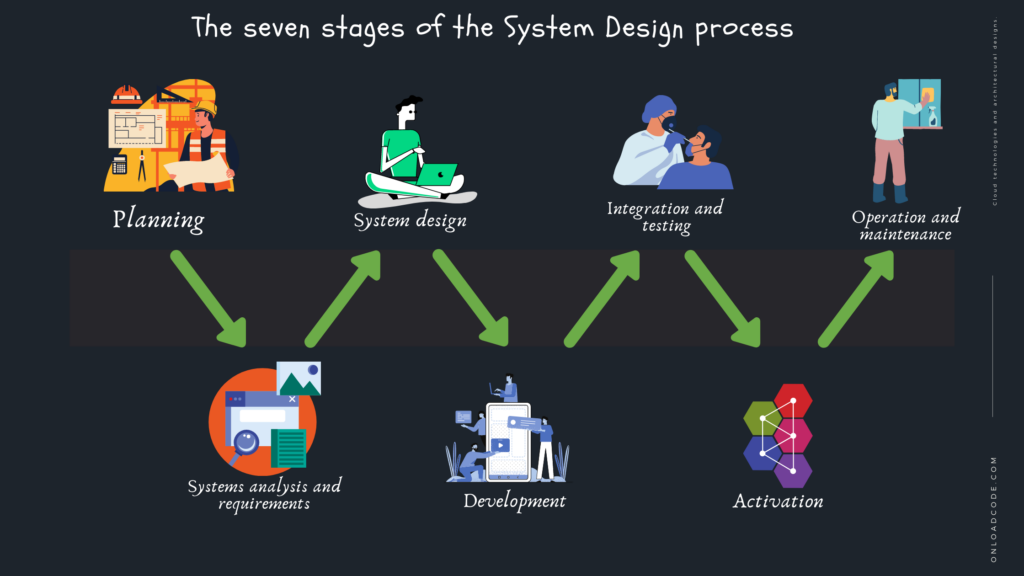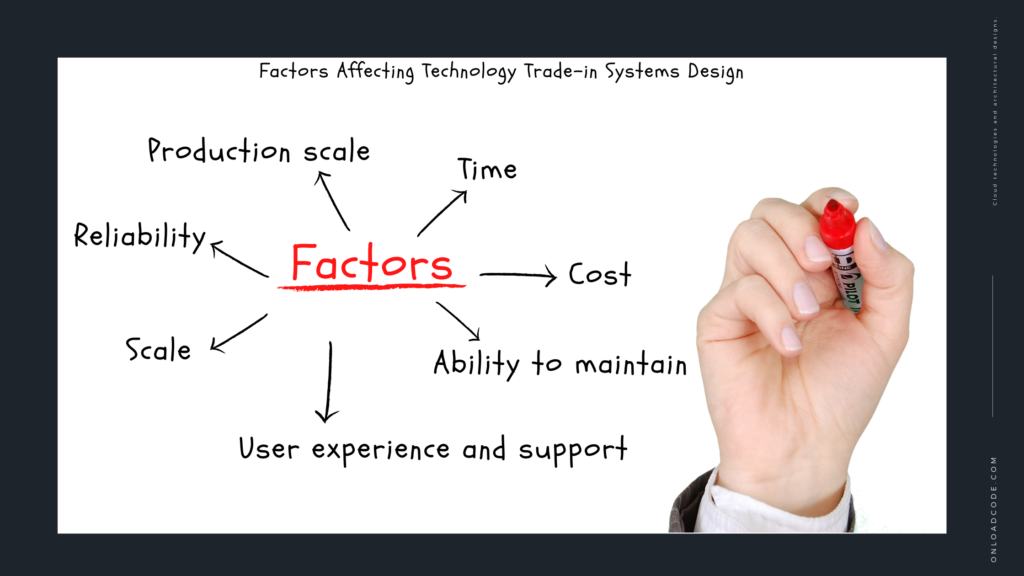This article is the first article on the System Design and Software Architecture series. In this article, we are discussing base introduction and principles regarding System design and architecture.
What is system design?
The system design is the process of understanding the overall requirements of a system, such as architecture, modules, interface, and design. We can say that system design ranges from discussing system requirements to product development. System Development Modifies or modifies the processes, applications, and methods used to develop a system. It is a need for a systematic approach to managing the system requirements and design methodology. System design classifies as a logical design and physical design. The logical design represents the abstract data flow, while the physical design represents the input and output processes of the system.
The objective of the system design process is to provide sufficiently detailed data. And information about the system and its system components so that they can implement by following the architectural entities defined by the models and ideas of the system architecture.
How does system design make work so easy?

Specializes in developing excellent artwork while saving time and labour. This helps to create plans for information systems. It uses to solve internal problems, increase efficiency, and expand opportunities. And it is the foundation of any business. also it contributes a lot to the success of the desired results and makes the work easier and simpler.
Elements of a system design
Architecture
This is the conceptual model that defines the structure, behaviour, and more ideas of a system. It also streams notes to illustrate architecture.
Modules
These are the components that handle one specific function of a system. The system has made up of a combination of modules.
Components
This provides a specific function or set of relevant functions. They have made up of modules.
Interface
This is the shared boundary between the system components that share and share information.
Data
This is information and data flow management.
The seven stages of the System Design process

1. Planning
This is the first stage in the system development process. It identifies whether a new system is needed to achieve a business’ strategic objective. Modifying or improving service. The company strives to meet or exceed the expectations of its employees, customers, and partners. The purpose of this step is to find the scope of the problem and determine solutions. In this case, resources, costs, time, benefits, and other items should consider.
2. Systems analysis and requirements
The second stage is where businesses act on the origin of their problem or the need for change. When a problem arises, possible solutions are proposed and analyzed to identify what is best suited for the ultimate goal of the project. This is where the functional need groups of the project or solution that consider. Also, it is where system analysis takes place or analyzes the needs of end-users to ensure that the new system meets their expectations. Systems analysis is very important in determining what a business needs, how it can meet, who is responsible for each part of the project, and what kind of time frame should expect.
Businesses have several tools that are specific to the second phase.
3. System design
Phase three describes in detail the specifications, features, and operations required to meet the functional requirements of the proposed system. This is a step for end-users to discuss and determine their specific business information requirements for the proposed system. At this stage, the essential components (hardware and/or software) structure (networking capabilities), configuration, and operational procedures will consider achieving the system objectives.
4. Development
The fourth stage is when the actual work begins – especially when a programmer, network engineer, and database developer brings in to do the main work of the project. This task involves using a flow chart to ensure that the system has properly organized. The developmental stage marks the end of the initial part of the process. Also, this stage symbolizes the beginning of production. The development phase also characterizes by inclusion and modification. Focusing on training at this stage can be a huge advantage.
5. Integration and testing
Systems Integration and Systems Testing (Programs and Procedures) – Usually a Quality Assurance (QA) is done by a professional to determine if the proposed design for Phase Five meets the start-up business objectives. The test can repeat to check for errors, omissions, and interactions. This test performs until the end-user can accept it. This phase also enables authentication and validation, both of which help to ensure the successful completion of the program.
6. Activation
The sixth stage is when the majority of the code for the program has written. Also, this stage involves the actual installation of the newly developed system. This step leads the project to production by moving data and components from the old system and inserting them directly into the new system via a cutter. This can be a risky (and complicated) step, but cutouts usually occur at peak times, thus minimizing the risk. Both system analysts and end-users must now see the realization of the project in which the changes have been implemented.
7. Operation and maintenance
The seventh and final stages include maintenance and necessary updates. This step allows end-users to enhance performance, add new capabilities, or meet additional user needs if they wish.
Factors Affecting Technology Trade-in Systems Design

Production scale
Usually, enterprise software companies that build system-level software prioritize reliability because customers want to use them. Every change must be rigorously inspected and often approved before it is released.
Consumer internet companies spend time and money customizing their UX, which requires people to use them. Credibility is something they are willing to sacrifice. Since most of them are web-based applications, they can quickly reconfigure, and changes issued frequently.
Time
It often takes time to learn new technologies. In this case, the trade will suspend depending on which technology is on time with the due delivery dates. Switching to new technology will make a big difference in delivery dates and can switch off until the appropriate time in the event of a major inconvenience to stakeholders.
Cost
Large-scale technical decisions are cheaper, comparable, and it would be more cost-effective to buy from a rack system and customize it or build a new system.
User experience and support
The amount of support and documentation available in a given technology is also a factor in decision making. It is easier to work with technologies that have a large support base, extensive documentation, and a good user experience, and because of the large number of resources available to support it, it takes time to shorten.
Ability to maintain
The maintenance capability, in this case, is the ease with which a product can be maintained for troubleshooting, debugging, and adding additional features. Decisions outside of trade are made based on the maintenance capabilities of the technology.
Reliability
In this case, the trade is suspended by constantly updating to better and more efficient versions based on technology.
Scale
Technology trading also bases on technologies that can be scaled up and handled more efficiently without a breakdown in technological efficiency.
What is system architecture?

Systems architecture is the general discipline of manipulating objects called “systems” to support the logic of the structural properties of these objects.
The architectural design focuses on understanding how a system should organize and designing the overall structure of that system. It can consider as the first stage in the software design process. There is a critical link between design and requirements engineering because it identifies the key structural components of a system and the relationships between them. The architectural design process’s output is an architectural model that describes how the system has been organized as a group of communication components.
It has generally accepted that in the early stages of development, care should take to establish overall system architecture at an early stage of the development process. Improvements in architecture are generally not successful. Redesigning components in response to changes is generally relatively easy. And redesigning system architecture can be costly.
Also practically, there is a significant overlap between the requirements engineering and architectural design processes. A system specification could not include any design information. This is not realistic except for very small systems.
Architectural disassembly is usually required to formulate and organize specifications. Therefore, as part of the requirements engineering process, you can propose abstract system architecture that combines system functions or components with large-scale components or subsystems. You can then use this decomposition to discuss system requirements and features with stakeholders.
You can design software architecture on two abstract levels, which Somerville calls architecture small and architectural largely:
Small Architecture cares about the architecture of individual programs. At this level, we are concerned with how a single program decomposes into components.
Architecture largely focuses on the architecture of complex enterprise systems that include other systems, programs, and program components. These enterprise systems distribute across different computers, which are owned and managed by different companies.
The three main advantages of designing and documenting software architecture are:
1. Communication of stakeholders.
Architecture is a high-level presentation of the system that can be focused on to be discussed by different stakeholders.
2. Systems analysis.
Some analysis is needed to explain the system architecture in the early stages of system development. Architectural design decisions have a profound effect on whether a system can meet critical requirements such as performance, reliability, and maintenance capability.
3. Large-scale reuse.
A model of system architecture is a compact, manageable description of how a system has been organized and how components interact. The system architecture is often the same for systems with similar needs, which can help reuse large-scale software.
People with different disciplines, who are involved in the system development process, can readily understand. However, despite their widespread use, several professionals dislike informal block diagrams for describing architecture. People are claiming that informal diagrams are poor architectural representations, as they show neither the type of the relationships among system components nor the components’ externally visible properties.
There are mainly two ways in which an architectural model of a program used:
A high-level architectural view of a system is a way useful for communication with system stakeholders and project planning. because it has not cluttered with detail. Stakeholders can discuss the system as a whole without being confused by detail. This architectural model identifies the key components that have to develop so managers can start assigning people to plan the development of these systems.
A way of documenting an architecture that has been designed. The main reason here is to produce a complete system model that shows the different components in a system, their interfaces, and their connections.
Block diagrams are another better method to describe the system layout in the design process, as they are a good way to support communication between people involved in the process. In many projects, these are often the only architectural documents available. However, to thoroughly document the architecture of a system. It is best to use a well-defined notation for the architectural description.
The difference between software design and software architecture

Software design provides software developers with everything they need to know to develop stable software that implements the required functionality. This includes specifications for services, components, integrations, data models, and algorithms.
Software architecture puts big picture barriers to design to ensure it is in line with an organization’s business and technological strategies. This includes compliance, technical standards, and operational efficiency. Architecture is about preventing known mistakes from being repeated or mismatched with other parts of the organization.
How do they relate?
Software architecture presents the structure of a system and hides execution details. Architecture also focuses on how elements and components in a system interact with each other. Software design explores in-depth information about system activation. Design concerns include details of data structures and algorithm selection or individual component implementation.
Architecture and design requirements often overlap. Instead of using strict and fast rules to distinguish between architecture and design, it makes sense to combine them. Sometimes decisions are more architectural. At other times, it focuses more on decision planning and helps to understand architecture.
To learn it more practically:
- Software design is a design that provides developers with sufficient information to implement stable software.
- Software architecture is a plan that prevents software design to avoid known mistakes to achieve the organization’s business and technological strategies.
- Level of software design: Implementation
- Level of Software Architecture: Structure
Conclusion
Thanks for reading the article introduction and principles regarding System design and architecture.
My articles on medium










Pingback: Programming Paradigm - Onload Code
Pingback: Software Architecture - Independence - Onload Code